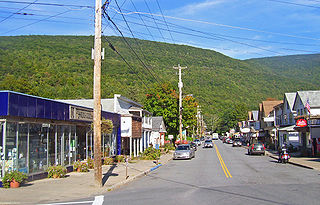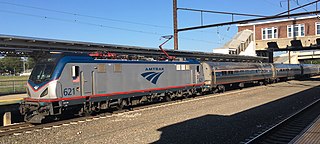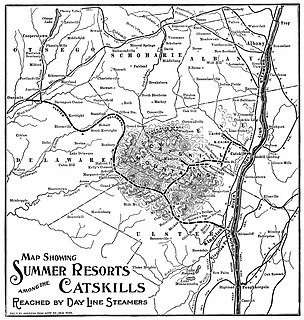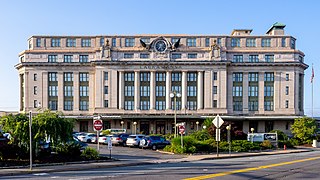
Phoenicia is a hamlet of Shandaken in Ulster County, New York, United States. The population was 309 at the 2010 census, making it the highest populated community in the town. The village center is located just off Route 28 at its junction with Route 214 and is nestled at the base of three peaks, Mount Tremper, Romer Mountain, and Sheridan Mountain. The community sits at the confluence of the Esopus Creek and Stony Clove Creek. A popular getaway for New Yorkers, the hamlet has frequented many tourism guides as among the best vacation towns in the greater New York City area.

Amtrak's 195-mile (314 km) Keystone Service provides frequent regional passenger train service between the Harrisburg Transportation Center in Harrisburg, Pennsylvania and 30th Street Station in Philadelphia, running along the Philadelphia to Harrisburg Main Line. Most trains continue along the Northeast Corridor (NEC) to Pennsylvania Station in New York.

The Ulster and Delaware Railroad (U&D) was a railroad located in the state of New York. It was often advertised as "The Only All-Rail Route to the Catskill Mountains." At its greatest extent, the U&D extended 107 miles (172 km) from Kingston Point on the Hudson River through the Catskill Mountains to its western terminus at Oneonta, passing through the counties of Ulster, Delaware, Schoharie and Otsego.

Newark Broad Street is a NJ Transit commuter rail and light rail station at 25 University Avenue in Newark in Essex County, New Jersey, United States. Built in 1903, the station's historic architecture includes an elegant clock tower and a brick and stone façade on the station's main building.

Ashokan was a former railroad station located in the Shokan section of the town of Olive, Ulster County, New York, United States. Located 16.2 miles (26.1 km) from the terminus at Kingston Point in Kingston, it was located along the Ulster and Delaware Railroad, later the Catskill Mountain Branch of the New York Central Railroad. The station opened on June 8, 1913, when the railroad abandoned their former alignment due to the construction of the Ashokan Reservoir. The railroad moved the station depot at Brown's Station to Ashokan for service.

The Boehlert Transportation Center at Union Station is a train station served by Amtrak and the Adirondack Railroad in Utica, New York. It is owned by Oneida County, and named for retired U.S. Rep. Sherwood Boehlert, R-New Hartford.

Summit is a train station in Summit, New Jersey, served by New Jersey Transit's Morris & Essex Lines. The station sits between Union Place on the north and Broad Street on the south, with station access via either side, and between Summit Avenue on the east and Maple Avenue on the west. Constructed in 1904–1905 by the Delaware, Lackawanna and Western Railroad in a mile-long open cut, it is one of the few NJ Transit stations with platforms below street level.

Cold Brook is a former railroad station in the Boiceville section of the town of Olive, Ulster County, New York, United States. Located on Cold Brook Road, just north of New York State Route 28A next to Esopus Creek, Cold Brook station served the New York Central Railroad's Catskill Mountain Branch, formerly the Ulster and Delaware Railroad. The station was located 22.1 miles (35.6 km) northwest of Kingston Point station in the city of Kingston.

Phoenicia station is a repurposed train station located on High Street just south of Phoenicia, New York, United States. It is a frame building that opened in 1899.
Grand Hotel station, MP 41.4 of the Ulster and Delaware Railroad, was located in the small mountain hamlet of Highmount, New York, at the summit between Big Indian and Arkville. A turntable was located here, allowing pusher engines to be turned before descending to Arkville or Big Indian.
The Arkville station, MP 48.1 on the Ulster and Delaware Railroad (U&D), and MP 37.52 on the Delaware and Northern Railroad (D&N), was another busy station, as this served as a junction between the two railroads. This station bore a strong resemblance to the Grand Hotel station and the Pine Hill station, which both looked like longer versions of the Mount Pleasant station.

The Wallkill Valley Railroad is a defunct railroad which once operated in Ulster and Orange counties in upstate New York. Its corridor was from Kingston in the north to Montgomery in the south, with a leased extension to Campbell Hall. It crossed both the Wallkill River and Rondout Creek.

Halcottville station, MP 53.0 on the Ulster and Delaware Railroad (U&D), served the hamlet of Halcottville. On February 1, 1932, the U&D became the Catskill Mountain Branch of the New York Central Railroad. In addition to the station, the U&D constructed a large ice-house here and stored ice from Lake Wawaka. A tiny steamboat, also named Wawaka, plied the lake during the summer months drawing visitors from up and down the line who rode the boat and picnicked on the shores of Lake Wawaka. Halcottville boasted a hotel, two creameries, an early electric light plant, several stores, a post office, dance hall, school, and several churches. There were also numerous boarding houses in the area.
Roxbury station is a disused train station on the former Ulster and Delaware Railroad / West Shore "Catskill Mountain Branch" in the hamlet of Roxbury, New York. The station is a contributing property to the Ulster and Delaware Railroad Depot and Mill Complex, a historic district on the National Register of Historic Places.
Stamford station, MP 74.0, was another important railroad station on the mainline of the Ulster and Delaware Railroad. The town it served, Stamford, New York, was home to the Stamford Country Club and the elegant Churchill Hall, and was, not surprisingly, a popular tourist stop, especially for people coming up from New York City. There were more hotels, apart from the Churchill Hall, along with many boarding houses.
There were four stations built to serve the city of Kingston, New York. The first station was known as "Higginsville Station" built by the Rondout & Oswego railroad company. The second station was served by three different railroads, all of which eventually became part of the New York Central railroad company. The third station, known as "Fair Street Station", replaced the Higginsville Station in 1882. The fourth station was for the New York, Ontario and Western Railway.

Haines Falls is an abandoned train station in Haines Falls, New York. It was owned by the Ulster and Delaware Railroad.
The Delaware and Ulster Railroad (DURR) is a heritage railroad based in Arkville, New York.

The Radisson Lackawanna Station Hotel, built as the Delaware, Lackawanna and Western Railroad Station, is a French Renaissance style building in Scranton, Pennsylvania. It was built as a train station and office building in 1908; closed in 1970; listed on the U.S. National Register of Historic Places on December 6, 1977; and renovated and reopened as a hotel in 1983.
The Del-Mar-Va Express was a named passenger train of the Pennsylvania Railroad that at its peak went from New York City to the southernmost point of the Delmarva Peninsula, Cape Charles, Virginia. Initiated in 1926, the train's north–south passage through Delaware stood in contrast with the main passenger traffic through Delaware being a brief passage through cities in the upper reach of Delaware, mainly Wilmington. Most importantly, the train served as a more direct path from New York City and Philadelphia to Norfolk, Virginia, by way of a ferry from Cape Charles across the Chesapeake Bay to Norfolk, a path that bypassed Baltimore and Washington, D.C. This saved time in comparison to travel over PRR, Atlantic Coast Line and Norfolk & Western trains through Washington to Norfolk. The Del-Mar-Va trip, including ferry travel was 11 hours from New York; and the longer all-land route through Washington was 13 hours and 40 minutes.













